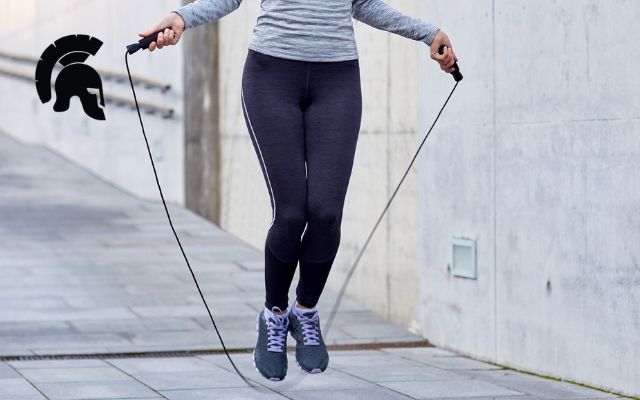Many people are concerned about how long they should jump rope to achieve their fitness goals. Whether you’re a seasoned athlete or just starting your fitness journey, figuring out the right workout duration can feel overwhelming. This post is designed to help you understand the ideal jump rope duration based on your fitness level, goals, and intensity. I’ll provide a personalized roadmap, covering everything from beginner workouts to advanced routines, so you can optimize your jump rope sessions for maximum results.
The Perfect Jump Rope Cardio Session
Your current fitness level is a crucial factor in determining your jump rope workout duration. Beginners should prioritize mastering proper form over extended durations. Starting with shorter sessions (2-5 minutes) allows your body to adjust to the activity and reduces the risk of injury. As you progress, you can gradually increase the duration and intensity.
Intermediate jumpers can aim for 5-15 minutes of continuous jumping, incorporating intervals for variation. These intervals might involve different jump styles or short rest periods. Listen carefully to your body during this phase. You are building endurance and becoming comfortable with the workout.
Advanced jumpers, on the other hand, can explore longer sessions (15 minutes+), incorporating more complex jump patterns and higher intensity intervals. This allows you to push your physical boundaries and maximize the workout’s effectiveness. You might include advanced jumping routines that involve different combinations of movements.
Defining Your Goals
Your fitness objectives should also guide your workout duration. For weight loss, longer sessions (20-45 minutes) with moderate-to-high intensity intervals are often recommended. However, prioritizing recovery and listening to your body is essential. Pushing yourself too hard, especially in the beginning, might lead to injuries. Don’t forget rest days are just as important as workout days.
Muscle toning benefits from combining jump rope with strength training. You might incorporate moderate-intensity workouts for longer durations (15-30 minutes). Remember to focus on proper form and gradually increase the intensity. This combination approach effectively targets both cardio and muscle development.
General cardiovascular health might require shorter workouts (10-30 minutes) depending on your level. Mixing moderate-intensity periods with bursts of high-intensity intervals allows your body to work efficiently, boosting your overall heart health. Don’t be afraid to adjust your routine as your body adapts.
Intensity and Intervals
Intensity plays a critical role in optimizing your jump rope cardio session. High-intensity workouts entail short bursts of intense jumping, leading to greater calorie burn and improved cardiovascular fitness. These high-intensity sessions can be crucial for pushing your body’s boundaries and maximizing calorie expenditure.
Moderate-intensity sessions involve sustained jumping at a manageable pace. These sessions are excellent for fat burning and building endurance. Consistent moderate-intensity exercise promotes a gradual improvement in cardiovascular health. These sessions contribute to consistent results and long-term fitness gains.
Interval training combines high and moderate intensities for a more effective workout. This approach maximizes your metabolic rate and challenges your cardiovascular system effectively. This dynamic variation in intensity is highly effective for weight management and sustained fitness.
Jump Rope for Cardio: 5-Minute, 10-Minute, and Longer Workouts
5-Minute Workout
A 5-minute jump rope workout is ideal for beginners or those seeking quick cardio bursts. Focus on mastering proper form. Gradually increase the duration as your fitness improves. This duration is manageable for individuals starting their fitness journey and it allows for easy adjustment.
A 5-minute jump rope workout can serve as a valuable addition to your daily routine. It can help build a foundation for more intensive workouts. Starting with a 5-minute routine allows you to focus on proper technique and form without overwhelming yourself.
This short workout will help increase your metabolism in a short period of time. These short bursts of activity are excellent for raising your heart rate and improving cardiovascular health.
10-Minute Workout
A 10-minute jump rope workout serves as an excellent starting point for moderate-intensity cardio. Incorporate intervals and different jump styles to keep your workout engaging. A 10-minute jump rope session is a great option for individuals seeking to develop a regular workout routine.
A 10-minute jump rope workout is an excellent way to improve your cardiovascular health and burn calories. Incorporating intervals and variations helps to keep your workout engaging and prevents boredom, keeping you motivated throughout the session.
This duration allows you to establish a consistent workout routine. This structured approach promotes consistent fitness growth and helps you develop a healthy fitness habit.
Longer Workouts (15+ Minutes)
Longer workouts (15+ minutes) are ideal for weight loss and advanced cardio training. Incorporate more complex jump patterns and high-intensity intervals to challenge your cardiovascular system effectively. This duration is best for individuals who have been consistent with their workouts for some time.
Longer workouts enhance cardiovascular health and improve endurance. By increasing the duration, you can maximize calorie expenditure and improve your overall fitness level. This increased workout time allows for more rigorous workout sessions.
These longer workouts help to achieve your fitness goals. They allow you to experience enhanced physical and mental well-being.
Jump Rope Cardio: Beginner, Intermediate, & Advanced Workout Times
Beginner Workout Structure
Beginners should focus on mastering proper form and gradual progression. A typical beginner workout might consist of a 1-2 minute warm-up, 2-5 minutes of jump rope, and a 1-2 minute cool-down. Rest periods are essential for recovery, and pushing yourself too hard can lead to injuries, so don’t rush the process. Listen to your body.
Beginners should start with short, manageable intervals and focus on proper form. Listen to your body and rest when needed to avoid injuries. A structured workout routine will help beginners adapt to the exercise.
Beginning with a short routine is crucial to developing a fitness habit. Gradually increase the duration as your body gets used to the activity.
Intermediate Workout Structure
Intermediate jumpers can build on their foundation with a more intensive workout structure. A 3-5 minute warm-up, 5-15 minutes of jump rope incorporating intervals and different jump styles, and a 3-5 minute cool-down are a good starting point. Adjust the time based on your body’s response.
Intermediate jump rope workouts aim to build on established skills. Gradually increasing intensity and incorporating more complex patterns will optimize your results. It’s essential to listen to your body and modify your routine as necessary.
This structured approach leads to consistent progress and helps to build your stamina.
Advanced Workout Structure
Advanced jumpers can push their limits by implementing a more challenging workout structure. A 5+ minute warm-up incorporating dynamic stretches, 15+ minutes of jump rope with diverse jump styles and high-intensity intervals, and a 5+ minute cool-down are suitable options. Listen carefully to your body to avoid overexertion.
Advanced jumpers benefit from intense, high-intensity workouts. This approach pushes their limits and maximizes calorie burning and cardiovascular health gains. It’s crucial to incorporate dynamic stretches into your warm-up to prevent injuries.
Advanced routines push the limits of your fitness capabilities. They are a testament to your dedication to physical well-being.
Maximize Your Jump Rope Cardio: Optimal Workout Lengths
Recovery and Rest
Recovery is just as crucial as the workout itself. Listen to your body. Don’t hesitate to take rest days between jump rope sessions, and avoid pushing yourself too hard, especially when starting. Proper rest allows for muscle repair and prevents potential injuries.
Adequate recovery time is vital for avoiding injuries and maximizing results. Don’t push yourself too hard, particularly when starting a jump rope routine. Listen to your body to allow for proper recovery between workouts.
Rest periods are essential to prevent burnout and promote consistent progress. Regular rest days allow your body to replenish, recover, and adapt to the demands of exercise. Allow for proper recovery.
Integrating into Your Routine
Jump rope can be seamlessly integrated into a comprehensive workout routine. Consider jump rope as a component of a larger workout plan, complementing other exercises such as strength training or other cardio. Consistency is key.
Integrating jump rope into a well-rounded fitness routine can greatly enhance your results. It complements other exercises, boosting your overall physical health and fitness gains.
Adding jump rope to your schedule can enhance your fitness journey.
Jump Rope Injuries and Prevention
Common Injuries
Common jump rope injuries include ankle sprains, shoulder pain, and knee pain. These injuries often stem from improper form or overexertion. Recognizing potential issues is key to avoiding them.
Ankle sprains, shoulder pain, and knee pain are potential jump rope injuries. Understanding these common issues helps to take preventive measures during workouts.
Paying attention to pain and form during your workout will prevent injury and allow you to continue your workouts.
Preventing Injuries
Preventing injuries is paramount. Proper technique is critical. Start slowly and gradually increase intensity to allow your body to adapt. Wear supportive footwear. A proper warm-up and cool-down are essential for injury prevention.
Maintaining proper form when jump roping is key to injury prevention. Start with gradual increases in intensity and duration to minimize the risk of muscle strains, joint pain, and other injuries.
Proper warm-up and cool-down routines are essential for injury prevention. It will help prepare your body for the activity and allow for the proper recovery.
Proper Technique and Variations
Proper Technique
Mastering proper jump rope form is crucial for injury prevention and maximizing results. Learn the correct footwork and arm movements to execute jumps efficiently and effectively. Good form is a cornerstone for a successful jump rope workout.
Proper jump rope technique ensures that your body moves in a way that reduces strain on your joints. By ensuring proper technique, you can prevent potential injuries. Good form is essential to avoid injuries.
Proper technique is the foundation for effective and injury-free jumping. Ensuring proper form prevents injuries and maximizes the effectiveness of your workout.
Variations
Explore different jump styles to keep your workouts engaging and challenging. These variations improve overall fitness, including single jumps, double jumps, high knees, and crossovers. Mixing things up prevents boredom and promotes effective muscle engagement.
Varying jump rope styles keeps your workouts challenging and interesting. Incorporating various jumps can work different muscle groups, leading to more comprehensive fitness benefits. This ensures a comprehensive and effective workout routine.
Introducing variations to your jump rope routines prevents plateaus in your fitness and maximizes the benefits of the workout.
Warm-up and Cool-down
Importance
Warm-up and cool-down routines are essential for injury prevention and performance enhancement. Preparing your muscles for activity and allowing them to gradually recover after exercise are crucial. Warm-up and cool-down are vital for preventing potential injuries.
Warm-up and cool-down routines are crucial for both injury prevention and enhanced performance. Proper warm-up before exercising prepares your muscles for the activity, and cool-down after exercise allows your muscles to recover and prevents soreness.
Warm-up and cool-down routines are a cornerstone of successful workouts. They ensure your body is ready to exercise, minimizing the risk of injuries and ensuring proper recovery. It’s crucial to remember this step for a safe and effective exercise routine.
Duration
A 5-10 minute warm-up is ideal before your workout. This will include dynamic stretching. A 5-10 minute cool-down after your workout, including static stretching, is equally important. Remember that listening to your body is essential.
Warm-up and cool-down should be considered integral parts of your workout routine. Their duration may vary but the importance remains consistent. Listening to your body and modifying the duration as needed is key.
The duration of your warm-up and cool-down is important for preparing your muscles to perform exercises and ensuring that you give your body the appropriate recovery time. Don’t underestimate the value of these crucial steps.
Measuring Progress and Adjustment
Tracking Progress
Tracking your progress is vital for monitoring your fitness journey. Monitor your heart rate, distance covered, and perceived exertion to gauge your improvement. Tracking these metrics provides valuable insights into your fitness journey.
Tracking your progress enables you to assess your fitness improvements over time. This process allows you to identify areas that need adjustment in your routine to achieve your desired outcomes. Monitoring progress is a critical component of sustained progress.
Tracking your progress allows you to monitor improvements. This will motivate you to keep working towards your goals and help you stay motivated. Tracking allows you to adapt to your routine and maximize effectiveness.
Adjusting Workouts
Adjusting your workouts is key to continuous improvement. Gradually increase the duration, intensity, or complexity of your workouts based on your progress and listen to your body. Adaptation is vital for optimal outcomes.
Regularly adjusting your jump rope workouts is essential to ensure continued progress. Listening to your body and making gradual adjustments to intensity and duration is crucial to sustain your fitness journey. This allows you to avoid plateaus.
Adjusting your workouts enables you to adapt to your body’s feedback and maximize the effectiveness of your routine. This helps you reach optimal fitness levels.
Alternatives to Jump Rope
Other Cardio Options
If jump rope isn’t your thing, explore other cardiovascular options. Consider activities like running, swimming, cycling, or bodyweight exercises. There are many effective ways to achieve your fitness goals.
Explore alternative cardio options to achieve the same fitness benefits. Running, swimming, cycling, and bodyweight exercises are great alternatives to jump rope, catering to different preferences and fitness levels.
Don’t be afraid to experiment with different cardio options to find what works best for you. Discover activities that keep you motivated and engaged throughout your fitness journey.








